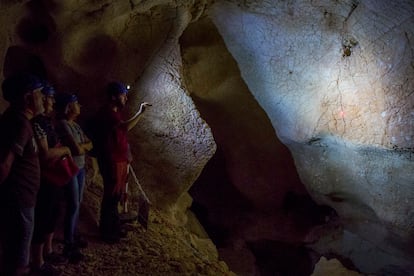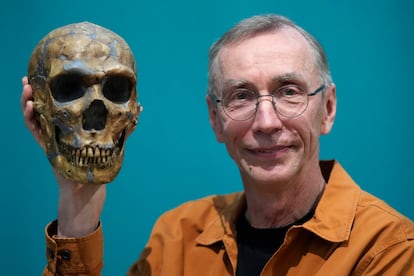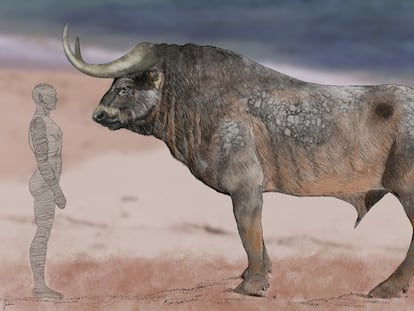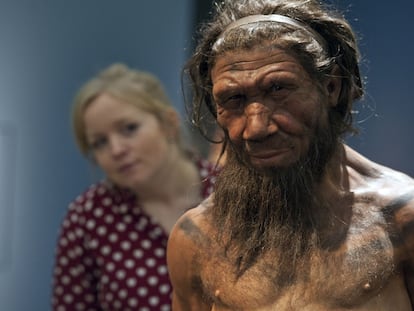New research aims to solve the riddle of Neanderthal extinction
Prehistoric ashes and stalagmites offer fresh clues to the fate of these hominins, who may have been victims of climate change or bred out of existence

Neanderthals inhabited what is now Europe and Asia for more than 350,000 years until suddenly, at least by evolutionary standards, they disappeared around 40,000 years ago. This occurred at around the same time as the emergence in Africa of Homo sapiens, the first anatomically modern human being.
With their characteristic sloping forehead, large pelvis, and wide nose, Homo neanderthalensis left behind one of the great mysteries of human evolution. They thrived during the Middle and Late Pleistocene periods, from about 400,000 years ago to approximately 40,000 years ago, ranging across Eurasia. Traces of their presence have been found from the north, in what is now Belgium, to the south, in the Mediterranean and Southwest Asia.
However, they were not the only hominins (human-like species) in existence on Earth at the time. Other archaic human groups, such as Homo floresiensis and the Denisovans, also inhabited our planet, largely in the Asia region. The genetic study of these different populations of archaic humans, known as paleogenomics, led to Svante Pääbo receiving the Nobel Prize for Medicine and Physiology last week. But now new forms of study are opening up, such as the study of ashes and stalagmites.
“In the time of the Neanderthals there were several human species and yet suddenly, 40,000 years ago, all but one disappeared,” says Stefano Benazzi, a professor at the University of Bologna (Italy). Benazzi is a physical anthropologist who directs the SUCCESS project, funded by the EU’s Horizon Europe program, which investigates the first migrations of Homo sapiens in Italy. “It’s important to understand what happened,” Benazzi notes.
Through thousands of objects and fossils uncovered during archaeological excavations, as well as several almost complete skeletons that are preserved in museums, we know more about Neanderthals than about any other extinct human species. There are several hypotheses on the disappearance of the Neanderthals: some point to climate change, others to clashes with Homo sapiens, competition for resources, disease and even to mating habits - that they were essentially bred into extinction by interacting with Homo sapiens. Some modern human populations in Europe and Asia have DNA profiles that contain up to 3% Neanderthal.
Benazzi has researched what became of the Neanderthals in Italy at around the same time Homo sapiens arrived from Africa. “In Italy we have many archaeological sites and we have a good overview of the different cultures that existed during the period in question,” he says. Several experts believe that climate change could have been a factor in driving Neanderthals to extinction. While this may be true elsewhere, it is not the case in Italy, Benazzi notes.
“In the time of the Neanderthals there were several human species and yet suddenly, 40,000 years ago, all but one disappeared”Stefano Benazzi, physical anthropologist and director of the SUCCESS project
The SUCCESS project was able to analyze granules from the cores of paleolakes - prehistoric lakes - by extracting minerals from stalactites. These calcareous formations that hang from the ceilings of caves are, in effect, climatic time machines, which allow the research staff to determine what the climate was like when they formed.
As a result, Benazzi and his team were able to reconstruct the paleoclimate of the region from between 40,000 to 60,000 years ago. Unlike the findings from analyses of ice cores in Greenland, there was no data indicating devastating climate change in Italy. As such, it is unlikely that this could have been a contributing factor to the extinction of the Neanderthals.
The project’s research staff closely examined a period of about 3,000 years during which populations of Neanderthals and Homo sapiens could have coexisted, excavating seven sites these species were known to have inhabited and studying cultural and tool-making differences between the last Neanderthals and the first modern humans in Italy.
Early Homo sapiens in Italy used specific types of technology, such as shell ornaments and projectiles, including arrowheads. In fact, the SUCCESS project identified the first indications of mechanically launched projectile weapons in Europe during its research.

A prehistoric arms race
Neanderthals would have been at a serious disadvantage compared to their Homo sapiens relatives when it came to weaponry. However, an encounter between the two species may never have happened in Italy.
Remains recently discovered in southern Europe confirm that at least one Neanderthal specimen existed 44,000 years ago, while the oldest Homo sapiens remains date from 43,000 years ago. It is possible they may have coincided but none of the current evidence is conclusive, notes Benazzi. However, these timelines vary from region to region. “The fact that you get certain results here [in Italy] doesn’t imply that you will get the same results elsewhere,” he points out.
Within the framework of the PALEOCHAR project, Carolina Mallol, a geoarchaeologist at the University of La Laguna in Tenerife and a visiting professor at the University of California, Davis, is examining the very ashes of time, searching for traces of Neanderthal life and potential clues as to their disappearance. The goal of the project is to study microscopic and molecular carbonized matter in prehistoric fire sediments to determine what organic material they may have left behind.
“The disadvantage archaeologists face is that the human world is organic and we cannot delve into it,” says Mallol. When organic matter such as meat or plants is thrown into a fire, the heat dehydrates it and eventually destroys its DNA and protein. But fatty molecules called lipids can survive at temperatures of less than around 350 degrees Celsius, as Mallol and other members of the project demonstrate in their research.
“PALEOCHAR was conceived to determine the scope of analytical techniques in the extraction of molecular information from the organic black layers [of fires]”, Mallol says. Paleolipidomics (the study of prehistoric fats) has been used to study lipids from Roman amphorae, Egyptian mummies and even prehistoric leaves. When it comes to prehistoric human sediments, Mallol notes that the PALEOCHAR research group is “the first to apply [these techniques] systematically.” The team is also expanding on known lipid biomarkers, which are like molecular “barcodes” specific to species, families, or even metabolic pathways. “With biomarkers, herbivores can be distinguished from carnivores, and conifers from angiosperms [flowering plants]”, Mallol explains.
Mallol and her team created the world’s first AMBI Lab (Archaeological Micromorphology and Biomarkers Research Laboratory), based in Tenerife, which trains research staff in soil micromorphology techniques and lipid biomarker analysis. Questions about Neanderthals, such as why they went extinct, remain very ambitious though in Mallol’s opinion. “Those questions involve first determining who they were and how they lived, and that requires a lot of information that we don’t yet have,” she says.
With each new piece of information, the scientific community and archeological specialists delve deeper into the mystery of why our closest relatives suddenly disappeared from the face of the planet while Homo sapiens managed to survive and flourish.
The research referred to in this article has been funded through the EU’s European Research Council and the article was originally published in Horizon, the EU’s Research and Innovation journal.
Tu suscripción se está usando en otro dispositivo
¿Quieres añadir otro usuario a tu suscripción?
Si continúas leyendo en este dispositivo, no se podrá leer en el otro.
FlechaTu suscripción se está usando en otro dispositivo y solo puedes acceder a EL PAÍS desde un dispositivo a la vez.
Si quieres compartir tu cuenta, cambia tu suscripción a la modalidad Premium, así podrás añadir otro usuario. Cada uno accederá con su propia cuenta de email, lo que os permitirá personalizar vuestra experiencia en EL PAÍS.
¿Tienes una suscripción de empresa? Accede aquí para contratar más cuentas.
En el caso de no saber quién está usando tu cuenta, te recomendamos cambiar tu contraseña aquí.
Si decides continuar compartiendo tu cuenta, este mensaje se mostrará en tu dispositivo y en el de la otra persona que está usando tu cuenta de forma indefinida, afectando a tu experiencia de lectura. Puedes consultar aquí los términos y condiciones de la suscripción digital.
More information
Últimas noticias
Most viewed
- Sinaloa Cartel war is taking its toll on Los Chapitos
- Reinhard Genzel, Nobel laureate in physics: ‘One-minute videos will never give you the truth’
- Oona Chaplin: ‘I told James Cameron that I was living in a treehouse and starting a permaculture project with a friend’
- Why the price of coffee has skyrocketed: from Brazilian plantations to specialty coffee houses
- David King, chemist: ‘There are scientists studying how to cool the planet; nobody should stop these experiments from happening’










































